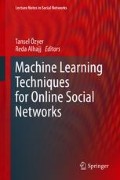Abstract
We studied the dynamic network of relationships among avatars in the massively multiplayer online game Planetside 2. In the spring of 2014, two separate servers of this game were merged, and as a result, two previously distinct networks were combined into one. We observed the evolution of this network in the 7 month period following the merger. We found that some structures of original networks persist in the combined network for a long time after the merger. As the original avatars are gradually removed, these structures slowly dissolve, but they remain observable for a surprisingly long time. We present a number of visualizations illustrating the post-merger dynamics and discuss time evolution of selected quantities characterizing the topology of the network.
Access this chapter
Tax calculation will be finalised at checkout
Purchases are for personal use only
Notes
- 1.
In game communities, outfits are formed by players, for organization and socialization. This is the same as clans or guilds in other MMOGs.
- 2.
Except for the highest degree avatar, whose size is limited to twice that of the second largest.
- 3.
Ninety-six is the number of avatars in two 48-player platoons, and close to the minimum degree of an avatar in the heavy tail of the degree distribution [10].
- 4.
If it only has one neighbor randomly pick another node and add an edge and proceed as normal.
References
Clements, J., Farzad, B., Fuk, H.: Dynamics of large scale networks following a merger. In: 2016 IEEE/ACM International Conference on Advances in Social Networks Analysis and Mining (ASONAM), Aug 2016, pp. 471–476
Lazer, D., Pentland, A.S., Adamic, L., Aral, S., Barabasi, A.L., Brewer, D., Christakis, N., Contractor, N., Fowler, J., Gutmann, M., Jebara, T., King, G., Macy, M., Roy, D., Van Alstyne, M.: Life in the network: the coming age of computational social science. Science 323(5915), 721–723 (2009). http://www.ncbi.nlm.nih.gov/pmc/articles/PMC2745217/
Kwak, H., Chun, H., Moon, S.: Fragile online relationship: a first look at unfollow dynamics in twitter. In: Proceedings of the SIGCHI Conference on Human Factors in Computing Systems, ser. CHI 11, pp. 1091–1100. ACM, New York (2011). http://doi.acm.org/10.1145/1978942.1979104
Szell, M., Thurner, S.: Measuring social dynamics in a massive multiplayer online game. Social Netw. 32(4), 313–329 (2010). http://www.sciencedirect.com/science/article/pii/S0378873310000316
Son, S., Kang, A.R., Kim, H.-c., Kwon, T., Park, J., Kim, H.K.: Analysis of context dependence in social interaction networks of a massively multiplayer online role-playing game. PLoS One 7(4), e33918 (2012). http://dx.doi.org/10.1371/journal.pone.0033918
Shen, C., Monge, P., Williams, D.: Virtual brokerage and closure: network structure and social capital in a massively multiplayer online game. Commun. Res. 41(4), 459–480 (2014). http://crx.sagepub.com/content/early/2012/08/01/0093650212455197
Poor, N.: Collaboration via cooperation and competition: small community clustering in an MMO. In: 2014 47th Hawaii International Conference on System Sciences (HICSS), Jan 2014, pp. 1695–1704
Bastian, M., Heymann, S., Jacomy, M.: Gephi: an open source software for exploring and manipulating networks, 2009. http://www.aaai.org/ocs/index.php/ICWSM/09/paper/view/154
Kadushin, C.: Understanding Social Networks, vol. 1, 1st edn. Oxford University Press, New York (2012)
Clauset, A., Shalizi, C., Newman, M.: Power-law distributions in empirical data. SIAM Rev. 51(4), 661–703 (2009). http://epubs.siam.org/doi/abs/10.1137/070710111
Newman, M.E.J.: Modularity and community structure in networks. Proc. Natl. Acad. Sci. 103(23), 8577–8582 (2006). http://www.pnas.org/content/103/23/8577.abstract
Barabsi, A.-L., Albert, R.: Emergence of scaling in random networks. Science 286(5439), 509512 (1999). http://www.sciencemag.org/content/286/5439/509
Davidsen, J., Ebel, H., Bornholdt, S.: Emergence of a small world from local interactions: modeling acquaintance networks. Phys. Rev. Lett. 88(12), 128701 (2002)
Hanneke, S., Fu, W., Xing, E.P.: Discrete temporal models of social networks. Electron. J. Stat. 4, 585–605 (2010). http://projecteuclid.org/euclid.ejs/1276694116
Welles, B.F., Vashevko, A., Bennett, N., Contractor, N.: Dynamic models of communication in an online friendship network. Commun. Methods Meas. 8(4), 223–243 (2014). http://dx.doi.org/10.1080/19312458.2014.967843
Author information
Authors and Affiliations
Editor information
Editors and Affiliations
Rights and permissions
Copyright information
© 2018 Springer International Publishing AG, part of Springer Nature
About this chapter
Cite this chapter
Clements, J., Farzad, B., Fukś, H. (2018). Dynamics of Large-Scale Networks Following a Merger. In: Özyer, T., Alhajj, R. (eds) Machine Learning Techniques for Online Social Networks. Lecture Notes in Social Networks. Springer, Cham. https://doi.org/10.1007/978-3-319-89932-9_9
Download citation
DOI: https://doi.org/10.1007/978-3-319-89932-9_9
Published:
Publisher Name: Springer, Cham
Print ISBN: 978-3-319-89931-2
Online ISBN: 978-3-319-89932-9
eBook Packages: Social SciencesSocial Sciences (R0)

